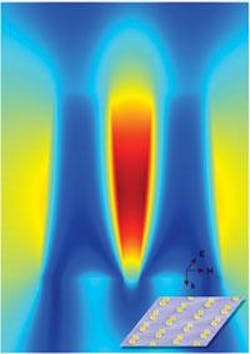NEGATIVE REFRACTION: Nanofabrication creates left-handed materials at optical wavelengths

The creation of an optical lens based on negative refraction, and thus capable of imaging features smaller than the light’s wavelength, has been hampered because the contribution that natural materials make to total magnetic flux density when placed in a magnetic field (magnetic susceptibility) becomes negligible at high frequencies, beginning in the microwave region. After being artificially extended into the microwave region five years ago using left-handed materials, however, magnetic properties were further extended into the visible spectrum last year using nanofabrication techniques.
In 2000, John Pendry at Imperial College (London, England) proposed the idea of exploiting the inductive response from structured nonmagnetic materials to obtain high-frequency magnetism. Later that year David Smith, Sheldon Schultz, and colleagues at the University of California-San Diego successfully implemented the idea using arrays of copper split rings to generate a magnetic response at frequencies of several gigahertz, which was soon improved to 100 THz (see www.laserfocusworld.com/articles/204014). The emergence of magnetic properties was attributed to collective motion of a large number of electrons. Attempting to replicate the experiment at visible wavelengths would have required split-ring-like structures with sizes down to 100 nm and critical features controlled on the level of 10 nm, however.
Array of pillar pairs
Last year, researchers at the University of Manchester (England), Institute of Microelectronics Technologies (Chernogolovka, Russia), and Aston University (Birmingham, England) nanofabricated their way around the scaling concerns by suggesting a metallic nanoresonator of a new design. Their initiative was rewarded with the first observation of magnetic susceptibility at visible light frequencies (700 THz) attributed to theoretically predicted antisymmetric plasmon resonances in pairs of submicron-scale gold pillars (see figure).1
The researchers fabricated a 2-D array of pillar pairs on a glass substrate using high-resolution electron-beam lithography. The structures typically covered an area of on the order of 0.1 mm2 containing about a million pillars. Pillar heights ranging from 80 to 90 nm, and pillar diameters less than 100 nm, yielded plasmon resonance even in unpaired pillars at red-light wavelengths of about 670 nm.
Distances between paired pillars of 100 nm or less made electromagnetic interaction between paired pillars significant. A simulation using Femlab (Comsol; Burlington, MA) software showed that incident green (500-nm) light normal to the glass substrate with transverse magnetic polarization (electric field parallel to the vertical plane between each pillar pair) excited anti-phase currents flowing vertically within the pillars. A current loop was effectively created in the vertical plane between each pillar pair, generating a strong magnetic moment in the region between the pillars and oriented normal to the vertical plane.
While the research indicates that negative permeability and a negative refractive index-necessary conditions for achieving a negatively refracting left-handed material-are possible for visible light waves, actual negative refraction (that is, bending of light in the opposite direction from normal) has not yet been observed.
“This discovery could be a milestone for optics and could help to realize the visible-light left-handed materials which promise the perfect lens,” said research team leader Alexander Grigorenko, at the University of Manchester School of Physics and Astronomy and Manchester Centre for Mesoscience and Nanotechnology. “It also provides wherewithal for making new optical devices such as spasers and nanolasers.”
REFERENCE
1. A.N. Grigorenko, et al., Nature438(7066) 335 (Nov. 17, 2005).
Hassaun A. Jones-Bey | Senior Editor and Freelance Writer
Hassaun A. Jones-Bey was a senior editor and then freelance writer for Laser Focus World.